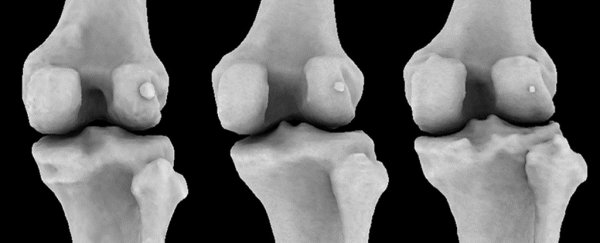A bone once thought to be almost lost to evolution and rare in modern humans is making a strange comeback.
Known as the fabella bone, this knee bone was once very rare in human beings, but is now three times more common in human knees than it was a hundred years ago.
That's based on an analysis of 21,676 knees carried out by researchers from Imperial College London in the UK. They looked at more than 58 published studies across 27 countries, stretching back as far as 1875.
In the earliest study the team found, from 1875, fabellae were present in 17.1 percent of the population studied.
From there, the team analysed more data points, and created a model for the world population. This showed that by 1918, only 11.2 percent of humans had fabellae, but in 2018 it had hit a lofty 39 percent – a 3.5-fold increase.
So what's going on? If experts actually knew what the fabella was for, we might have more of an idea – it's classed as a sesamoid bone, which means it grows in the tendon of a muscle, like the kneecap does.
"We don't know what the fabella's function is – nobody has ever looked into it," says one of the team, Michael Berthaume.
"The fabella may behave like other sesamoid bones to help reduce friction within tendons, redirecting muscle forces, or, as in the case of the kneecap, increasing the mechanical force of that muscle. Or it could be doing nothing at all."
What we do know is that the fabella is linked with knee pain and arthritis, though it doesn't necessarily cause it – people with osteoarthritis of the knee are twice as likely to have a fabella than people without osteoarthritis, for example.
There's also evidence that the fabella is much more prevalent in other mammals, like some species of monkeys, which leads to the question of how evolution might have played a part in deciding humans don't actually need these bones.
A hefty percentage of us get along just fine without a fabella, and the researchers aren't certain why it's becoming more common again.
One hypothesis is a link with growing levels of better nutrition – a trend that has been seen worldwide at the same time as the fabella has been making its comeback.
"The average human, today, is better nourished, meaning we are taller and heavier," says Berthaume. "This came with longer shin bones and larger calf muscles – changes which both put the knee under increasing pressure. This could explain why fabellae are more common now than they once were."
Sesamoid bones are known to grow bigger as more force is placed on them and as they are asked to do more work – but on the other hand the fabella is the only one of these bones that seems to be becoming more prevalent.
Another explanation is that we're now just better at detecting the fabella bone.
Obviously our rate of detection with MRI scans is better now than the occasional dissection or X-rays of old. That being said, some MRI scans can still miss the bone, especially if it's only small, and this might be one factor in the apparent rise.
We're going to need more data to find out for sure, and the team now wants to start breaking down the results by age, gender, location and other variables. The researchers are also going to investigate the likelihood of people having fabellae in both knees rather than just one.
Even if we don't get to the bottom of the mystery of the fabella's fall and rise, studies like this could help us to better understand how to treat painful knee conditions, and how those knee conditions might develop in the first place.
For now though, we just don't know what the fabella does or why we need it – only that it's making an almighty comeback.
"The fabella is a bone that has no apparent function and causes pain and discomfort to some and might require removal if it causes problems," says Berthaume.
"Perhaps the fabella will soon be known as the appendix of the skeleton."
The research has been published in the Journal of Anatomy.
